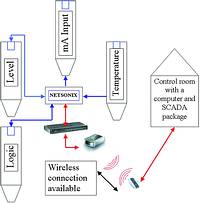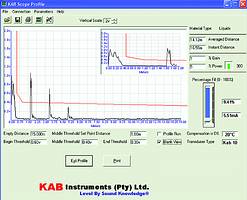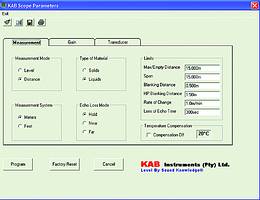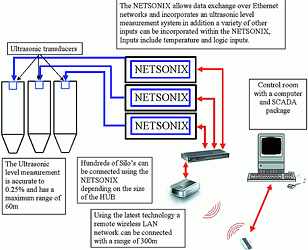

KAB Instruments, a Proudly South African company, with ISO 9001 and CE certification, believes that it has taken process instrumentation to a new technological level. Its Ethernet-based ‘Netsonix’ system includes an ultrasonic level or flow meter, thermocouple inputs, temperature inputs, current loop and voltage inputs. Connectivity between multiple devices on the same network is made easy using hubs or switches. The system is fully compatible with other PLCs and scada packages.

The Netsonix range of devices consists of ultrasonic level or flow transmitters, temperature measurement and analog input devices. The Netsonix 15 may be used for up to 15 m liquid/solids level. The Netsonix 30 is for up to 30 m solids/liquid level and the Netsonix 60 is for liquids/solids up to 60 m. Also available is the Netsonix Net-Analog, which is the 8-channel analog input module, and the Netsonix Net-Temp which is the 8-channel temperature input module. Using these Netsonix systems is as easy as connecting to an existing or new Ethernet Hub on a network, and they are up and running.
Prior devices and systems
PLCs (programmable logic controllers) and other data input and output devices have been used in the automation and control environment for many years. While these devices are effective in achieving the functionality they were intended for, they are nevertheless lacking the multifunctional abilities that are needed in the new era of automation, control and measurement processes that exists today.
Typically, the PLCs of today require specialised interface units to manage their I/O (input and output data). In the existing PLCs, different types of I/O would need different types of I/O cards. This means that the PLC system becomes bulky, and costs are driven upward. A significant weakness of the current PLCs is their lack of networking capability and communication protocols.
The Netsonix system
The Netsonix system is a multipurpose, multifunction PLC and/or measurement system/device. The Netsonix system is able to control, read, write and process single or multiple types of inputs and outputs. Using specific KAB Instruments' OPC server software, written for the Netsonix, the Netsonix is able to communicate through a standard network with thousands of packages, like scada (supervisory, control and data acquisition), and other PLCs, to give a visual interpretation of data it obtains. The OPC software also enables the Netsonix to be used as a standalone input and output card with a scada type package being used for a control and visualisation interpretation of the data obtained by the system/device. Communication with the Netsonix can also be made with other types of communication protocols and peripherals.
Netsonix components
The Netsonix consists of Netsonix Control (software), microprocessor (MCU), power supply, EPROM memory, conditioning circuitry, Ethernet module, RS232 serial communication circuitry - and the additional ability to add on a radio module, cellphone module, Bluetooth module and an infrared module. Netsonix is also available with wireless communication.
What the different parts of the Netsonix system do
* Netsonix control
This is the software, which has been loaded/programmed into the MCU. It enables communication between the communication modules and control of the Netsonix system/device. It integrates all the functionalities of the MCU.
* Microprocessor (MCU)
This is the device that the Netsonix control software runs on. The MCU communicates with outlying circuitry, which interfaces to the other peripherals used with the system/device.
* Power supply
This section conditions electrical power to supply the device/system, it converts AC-to-DC and/or DC-to-DC voltage levels to provide a stable electrical power supply for the Netsonix.
EEPROM memory
This is a memory chip that allows the MCU to store variables and other data needed for complete control of the device/system.
* Conditioning circuitry
These circuits connect to the I/O lines, MCU, communication modules and other peripherals together to result in a system, or device, that works. The circuitry also conditions I/O into readable signals that the MCU can interpret and process.
* Ethernet module
This is the main backbone for communication for the Netsonix device/system. It provides easy integration of data exchange between any server, computer or any other peripheral device and the Netsonix.
* RS232 serial communication circuitry
Provides alternate communication functionality with the Netsonix and any other device.
* Communication modules I/O data
These include the controlled outputs and the data inputs of the Netsonix. The system/device has the ability to control or receive seven different types of inputs and outputs namely:
- Single or multiple level transducer inputs and outputs.
- Single or multiple flow level inputs and outputs.
- Single or multiple cascaded one or two wire temperature sensors.
- Single or multiple relay outputs.
- Single or multiple analog inputs or outputs.
- Single or multiple digital inputs or outputs.
- Single or multiple loop inputs or outputs (4 to 20 ma).
All inputs and outputs have the ability to be voltage and current protected. EMIP (ElectroMagnetic Interference Protection) is also a consideration.


Ethernet module and other communication devices
The Netsonix communicates mainly with an Ethernet module. With this module, and specific OPC software designed for the Netsonix, the device can communicate with a multitude of other packages, like scada - other PLCs and visual interpretation devices and software. A user will also be able to acquire other modules for the device, for different types of communication hardware and protocols. Other such hardware modules will include:
* Radio module.
* Fire wire module.
* 485 communication module.
* Infrared communication module.
* Cellphone module.
* Bluetooth module.

Communication and visualisation to the outside world
As stated previously, the Netsonix can use many different types of hardware and software communication configurations. Interpreting the data that the Netsonix sends to a user is accomplished with visualisation software (like scada). The data can also be interpreted by other software, which is written specifically by the consumer, or for the customer by the engineers that designed the Netsonix. Any device, hardware or visualisation hardware/software used will need the same type of communication module that is fitted on the Netsonix.
To find out more about the Proudly South African campaign, visit the Proudly South African website: www.proudlysa.co.za
For more information contact KAB Instruments, 011 435 5380, [email protected]

© Technews Publishing (Pty) Ltd | All Rights Reserved